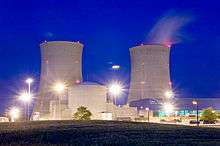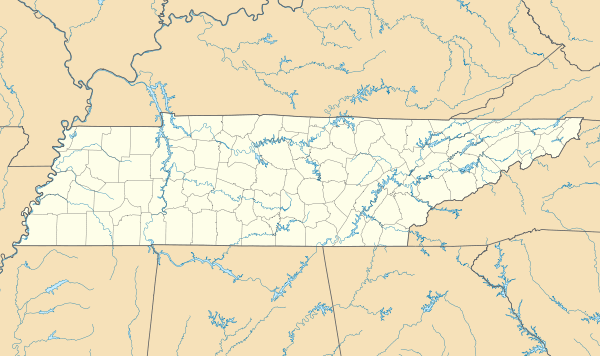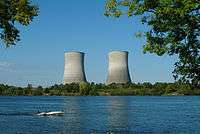Watts Bar Nuclear Generating Station
| Watts Bar Nuclear Plant | |
|---|---|
 Watts Bar Nuclear Power Plant Units 1 & 2 cooling towers and containment buildings. | |
 Location of Watts Bar Nuclear Plant in Tennessee | |
| Country | United States |
| Location | Rhea County, near Spring City, Tennessee |
| Coordinates | 35°36′10″N 84°47′22″W / 35.60278°N 84.78944°WCoordinates: 35°36′10″N 84°47′22″W / 35.60278°N 84.78944°W |
| Status | Operational |
| Construction began | 1973 |
| Commission date |
Unit 1: May 27, 1996 Unit 2: 3 October, 2016 |
| Operator(s) | Tennessee Valley Authority |
| Nuclear power station | |
| Reactor type | pressurized water reactor |
| Reactor supplier | Westinghouse |
| Cooling source | Tennessee River |
| Cooling towers | 2 |
| Power generation | |
| Units operational |
1 x 1,121 MW 1 x 1,218 MW |
| Nameplate capacity | 2,339 MW |
| Capacity factor | 102.3% |
| Estimated generation | 17,975 GW·h |
|
Website www.tva.gov/power/nuclear/wattsbar | |
The Watts Bar Nuclear Power Plant is a Tennessee Valley Authority (TVA) nuclear reactor used for electric power generation. It is located on a 1,770-acre (7.2 km²) site in Rhea County, Tennessee, near Spring City, between the cities of Chattanooga and Knoxville. Watts Bar supplies enough electricity for about 1,200,000 households in the Tennessee Valley.
The plant, construction of which began in 1973, has two Westinghouse pressurized water reactor units: Unit 1, completed in 1996, and Unit 2, completed in 2015. Unit 1 has a winter net dependable generating capacity of 1,167 megawatts. Unit 2 has a capacity of 1,165 megawatts. Unit 2 is the most recent civilian reactor to come on-line in the United States and the first new reactor to enter service in the United States after a 20 year hiatus.
Unit 2
Unit 2 was 80% complete when construction on both units was stopped in the 1980s due in part to a projected decrease in power demand.[1] In 2007, the Tennessee Valley Authority (TVA) Board approved completion of Unit 2 on August 1, and construction resumed on October 15.[2] The project was expected to cost $2.5 billion, and employ around 2,300 contractor workers. Once finished, it will create an estimated 250 permanent jobs.[3]
In response to severe damage to Japan's Fukushima-Daichi nuclear facility as a result of the 2011 Tohoku earthquake, the Nuclear Regulatory Commission (NRC) issued 9 orders to improve safety at domestic plants. Two applied to Watts Bar Unit 2 and required design modifications: "Mitigation Strategies Order"[4] and "Spent Fuel Pool Instrumentation Order".[5] In February 2012, TVA said the design modifications to Watts Bar 2 were partially responsible for the project running over budget and behind schedule.[1] The plant cost a total of US$4,700,000,000.[6]
TVA declared construction substantially complete in August 2015 and requested that NRC staff proceed with the final licensing review; on October 22, the NRC approved a forty-year operating license for Unit 2, marking the formal end of construction and allowing for the installation of nuclear fuel and subsequent testing.[7] On December 15, 2015, TVA announced that the reactor was fully loaded with fuel and ready for criticality and power ascension tests. On May 23, 2016, initial criticality was achieved.[8] As of August 31, 2016, a transformer fire had delayed the start of commercial operation past the late summer goal.[9] Commercial operation started in October 2016, once the affected transformer was replaced, operators completed the inspection on the switchyard affected equipment and the final full power testing was completed.[10] On October 19, 2016 the Watts Bar 2 was the first United States reactor to enter commercial operation since 1996.[11] It is likely the last Generation II reactor.[12]
Tritium production
The NRC operating license for Watts Bar was modified in September 2002 to allow TVA to irradiate tritium-producing burnable absorber rods at Watts Bar to produce tritium for the U.S. Department of Energy's (DOE's) National Nuclear Security Administration. The Watts Bar license amendment currently permits TVA to install up to 240 tritium-producing rods in Watts Bar Unit 1. Planned future license amendments would allow TVA to irradiate up to approximately 2,000 tritium-producing rods in the Watts Bar reactor.
TVA began irradiating tritium-producing rods at Watts Bar Unit 1 in the fall of 2003. TVA removed these rods from the reactor in the spring of 2005. DOE successfully shipped them to its tritium-extraction facility at Savannah River Site in South Carolina. DOE reimburses TVA for the cost of providing the irradiation services, and also pays TVA a fee for each tritium-producing rod that is irradiated.
Surrounding population

The NRC defines two emergency planning zones around nuclear power plants: a plume exposure pathway zone with a radius of 10 miles (16 km), concerned primarily with exposure to, and inhalation of, airborne radioactive contamination, and an ingestion pathway zone of about 50 miles (80 km), concerned primarily with ingestion of food and liquid contaminated by radioactivity.[13]
The 2010 U.S. population within 10 miles (16 km) of Watts Bar was 18,452, an increase of 4.1 percent in a decade, according to an analysis of U.S. Census data for msnbc.com. The 2010 U.S. population within 50 miles (80 km) was 1,186,648, an increase of 12.8 percent since 2000. The city center of Oak Ridge is located 37 miles (60 km) from the station.[14]
Seismic risk
The Nuclear Regulatory Commission's estimate of the risk each year of an earthquake intense enough to cause core damage to the reactor at Watts Bar was 1 in 27,778, according to an NRC study published in August 2010.[15][16]
See also
References
- 1 2 DiSavino, Scott (March 16, 2012). "TVA cuts contractors at Alabama Bellefonte nuclear site". Reuters.
- ↑ "WATTS BAR-2". PRIS. International Atomic Energy Agency. June 29, 2013. Retrieved June 29, 2013.
- ↑ "TVA: Watts Bar Nuclear Plant". Tennessee Valley Authority. February 10, 2008. Archived from the original on February 12, 2012. Retrieved March 14, 2012.
- ↑ "Mitigation Strategies". nrc.gov. Retrieved 2015-11-09.
- ↑ "Spent Fuel Pool Instrumentation Order". nrc.gov. Retrieved 2015-11-09.
- ↑ "TVA Awards Watts Bar, Sequoyah Outage Contract To Westinghouse". Nuclear Power News.
- ↑ "Watts Bar nuclear reactor granted operating license - first new U.S. reactor in 19 years". timesfreepress.com. Retrieved 2015-10-22.
- ↑ Today — Initial Criticality. www.tva.com. Retrieved 23 May 2016.
- ↑ "Transformer Fire Will Delay Watts Bar Unit 2 Commercial Operation". 31 August 2016.
- ↑ "Watts Bar power ascension tests completed". www.timesfreepress.com. Time Free Press. 3 October 2016. Archived from the original on 4 October 2016. Retrieved 4 October 2016.
The newest unit at the Watts Bar plant near Spring City, Tenn. is now producing more than 1,150 megawatts of electricity ...
- ↑ Blau, Max (2016-10-20). "First new US nuclear reactor in 20 years goes live". CNN.com. Cable News Network. Turner Broadcasting System, Inc. Retrieved 2016-10-20.
- ↑ Testa, Bridget (2012). "Three Generations of Nuclear Power Plants in the U.S.". Archived from the original on 9 March 2015. Retrieved 2015-04-08.
- ↑ "NRC: Backgrounder on Emergency Preparedness at Nuclear Power Plants". Fact Sheets. Nuclear Regulatory Commission. January 2009. Retrieved March 14, 2012.
- ↑ Dedman, Bill (April 14, 2011). "Nuclear neighbors: Population rises near US reactors". NBCNews.com. Retrieved May 1, 2011.
- ↑ Dedman, Bill (March 17, 2011). "What are the odds? US nuke plants ranked by quake risk". NBCNews.com. Retrieved April 19, 2011.
- ↑ Hiland, Patrick (2010-09-02). "Implications of Updated Probabilistic Seismic Hazard Estimates in Central and Eastern United States on Existing Plants" (PDF). MSNBC Media. Retrieved 2016-10-05.
External links
| Wikimedia Commons has media related to Watts Bar Nuclear Generating Station. |
- "Watts Bar Nuclear Plant". TVA. Retrieved 2008-11-16.
- "Response to Comments" (PDF). (2.70 MB)
- "Watts Bar Nuclear Plant, Tennessee". U.S. Department of Energy (DOE). October 10, 2008. Retrieved 2008-11-16.
- "Watts Bar 1 Pressurized Water Reactor". Operating Nuclear Power Reactors. U.S. Nuclear Regulatory Commission (NRC). February 14, 2008. Retrieved 2008-11-16.
- "Watts Bar Unit 2 Reactivation". NRC. July 31, 2008. Retrieved 2015-08-04.
- "History of Watts Bar Unit 2 Reactivation". NRC. June 9, 2008. Retrieved 2015-08-04.